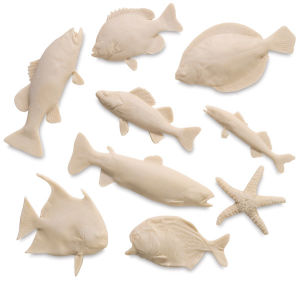
Ocean Anatomy: The Curious Parts & Pieces of the World Under the Sea
by Julia Rothman
I've taught the Ocean before as an Ecology block and in Science Club, but this time we are doing something new! I got each child a copy of Julia Rothman's wonderful Ocean book, and a special MLB called a middle school main lesson book. It alternates between lined pages and blank pages. My three Upper Elementary students (in Montessori this is ages 9-12) are doing a self-directed Ocean block where they get to use Julia Rothman's book as a resource, create their compositions about whatever portions of her book interest them the most, and do the art in whatever style interests them the most and makes sense for the given topic. My job will be to edit their rough drafts and to provide tutorials on the MANY art supplies in our Art Room! Besides that, the book is their very own creation.
They began with just colored pencils (Lyra Super Ferby and Prismacolor).
They are super-excited to have this freedom and to be trusted with each art supply as I "unlock" it (as one child called it). In Sudbury schools, this process is called certification. You get certified to use any area, piece of equipment, or educational material that requires a certain level of care and maturity. You have to re-certify at a given interval, and you can lose the certification if you do not show the appropriate care for the material. Sudbury schools and Montessori schools both operate under the principle of "freedom with responsibility."
It is interesting to see how much video game jargon has entered into everyday speech for the current generation. They like to "level up" in the difficulty of their work. And they are now looking forward to have me "unlock" new art supplies for them to use!
Note: For the next three weeks, the three First Graders will be doing their Waldorf Math Gnomes block. So they are very excited as well!
Monday, Mar 14
watercolor paper, paints, brushes, painting boards, masking tape
To kick off this topic, we did a mystery painting. This is a lesson I learned about from an art teacher in Hawai'i. You have the children paint the picture sideways so that they don't know what it is. When they rotate it, it becomes a landscape with mountains and a lake. Great fun... and it also could work for the MLB if they wanted to talk about the water cycle. All of the water on our planet was in the Ocean or will be in the Ocean at some point in time!
To help them be able to work more independently, I purchased some pre-cut watercolor paper. It's all Strathmore 140 lb cold press.
Tuesday, Mar 15
assorted papers for collage, other textures (burlap
& cork), glues
Today we talked about cut paper collage! We have so many texture options: construction paper, cardstock, handmade paper, decorative scrapbooking papers, and sheets of burlap and cork. We have glue sticks and liquid glue as adhesives (rubber cement must only be used with an adult present). I shared some picture book artists for inspiration (Steve Jenkins, Eric Carle) and Collage Workshop for Kids: Rip, snip, cut, and create with inspiration from The Eric Carle Museum by Shannon Merenstein.
Wednesday, Mar 16
chalk pastels, sponge applicators, hair spray, dry media paper (newsprint, drawing paper, pastel paper), adhesives, envelopes
Today they asked me to unlock chalk pastels. Chalk pastels are wonderful for blending and for any animal where you want to show gradations of color. We went over the kinds of dry media paper that work well for pastel, applicators, hairspray, and adhesives (3D foam squares, mounting squares). While we were on the subject of adhesives I also suggested that sometimes you may want to put an envelope in your MLB with something in it for the reader to discover. I was thinking about a string that was the length of some animal, so that the reader could take out the string and stretch it out, but one child thought of using the envelope to house a fun fact about the vampire squid!
Thursday, Mar 17
light box, transparency film, heavy vellum, tracing paper

Tuesday, Mar 22
acrylic paints (+ brushes and paint palettes), 6" square and 8" circle Gelli printing plates (+ brayer, cotton swabs, texture scrapers, sheets of wax paper, baby wipes), Tulip dimensional glow in the dark paint, fingertip texure stampers, assorted other materials for texture stamping (wooden spools, wine corks, acorn caps, lotus pods, etc.)
Wednesday, Mar 23
Daler-Rowney Acrylic Ink and Gyotaku Fish Printing Set, India ink
We also did a refresher on the black glue (dyed with India ink) and chalk pastel art technique. It takes two days but it's absolutely lovely. We've used this in the past for Georgia O'Keeffe inspired flowers and for trilobites.
Thursday, Mar 24
oil pastels, water-soluble oil pastels, Gelatos, watercolor pencils
We also did a refresher on the scratch art technique, where you cover the page with oil pastel and then apply two coats of black acrylic paint with a foam brush. Use a stylus to scratch away parts of the paint and reveal the color. I think this would be amazing for Ocean artwork about the Deep!
Monday, Apr 4
rubber stamps (both wooden and acrylic block), ink pads, reinkers, stamp cleaner, stencils
Wednesday, Apr 6
rubbing alcohol on watercolor technique
- from A Beautiful Way to Do Jellyfish Paintings blog post
I'll keep updating my notes as we go through this block!
This post contains affiliate links to materials I truly use for homeschooling. Qualifying purchases provide me with revenue. Thank you for your support!




















 Immersive Experience
Immersive Experience Immersive Experience
Immersive Experience







No comments:
Post a Comment